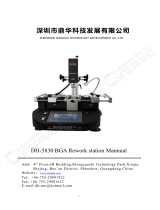Page is loading ...

Manufacturer:
AOYUE TONGYI ELECTRONIC EQUIPMENT FACTORY
Jishui Industrial Zone, Nantou, Zhongshan City,
Guangdong Province, P.R.China
http://www.aoyue.com
853A
PREHEA TER
Features:
◆ Digital temperature display with closed loop sensor that
Controls temperature.
◆ Wide range of adjustable temperature from 98℃~380℃.
◆ Large infrared quartz heater surface making circuit board
Preheating faster and more precise.

I. Specifications
Model: 853A
Power Consumption: 600W
Voltage: 220V / 50Hz±10% 110V / 60Hz±10%
Temperature Range: 98℃~380℃
Machine Dimensions: 220*247*73mm
Heating Surface: 130*130mm
II. Package Listing
1 Preheating Station 1 Circuit Board Holder
1 Power Cord 1 Instruction Manual
III. Application
Suitable fro repairing communication equipment and electronic
PCBs that require preheating.
IV. Operation
A. Preheating of Components (Use with rework stations).
1. Plug the power cord to power supply and place PCB on the circuit board
Holder. Adjust the holder in such a way that the component to be heated
Is at the center of the preheating surface.
2. Set the temperature according to the components’ size and circuit
boards’ thickness. Turn on the power switch. The station will start to
heat up and Stabilize at desired temperature.
B. Removal of Components
1. Place the PCB on the board holder and position the component to be
Removed at the center of the infrared heating surface.
2. Set the temperature according to component’s solder melting point.
Caution: Temperature setting is very important. A good command of
temperature setting is necessary since this could easily damage the PCB
or the components. The PCB could be deformed or burned If the
temperature is too high otherwise the component will not be detached if
the temperature is too low.
3. Turn on the machine and let the temperature stabilize, pay attention to
the components solder until it starts to shimmer. Use an IC popper to
remove the component when the solder is completely melted. Do not
move the PCB immediately after removing the component since it is still
hot and this will cause the movement of nearby components. Turn off the
power switch and wait for it cool down before removing the PCB.
/
